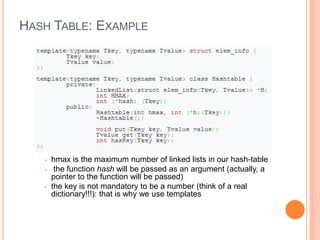Data structures and algorithms lab11
- 1. DATA STRUCTURES AND ALGORITHMS LAB 11 Bianca Tesila FILS, May 2014
- 2. OBJECTIVES Dictionaries Hash tables
- 3. DICTIONARIES: WHAT ARE THEY? An ADT made of a collection of keys and a collection of values, in which each key has a value associated to it A dictionary is also called associative array Useful for searching
- 4. DICTIONARIES: OPTIMAL SEARCH The keys must be unique The range of the key must be severly bounded Otherwise… if the keys are not unique: construct a set of m(keys count) lists and store the heads of these lists in the associative array(the keys)
- 5. DICTIONARIES: DUPLICATE KEYS If we have a high number of duplicates (a lot of elements with the same key), the search time will severely increase Solution: make a function to optimize the search criterion, h => solve collisions of keys We will search for T[h(k)] rather than T[k] , where: T is our associative array, k is an index and h(k) is a mapping function
- 6. DICTIONARIES: IMPLEMENTATION Hash-tables Self-balancing binary search trees Radix- tree Prefix-tree Judy arrays
- 7. DICTIONARIES: BASIC OPERATIONS put(key, value) Inserts the pair (key, value) in the hash table If a pair (key, value’) (with the same key) already exists, then value’ is replaced by value We say that the value value is associated to the key key get(key) Returns the value associated to the key key If no value is associated to key, then an error occurs hasKey(key) Returns 1 if the key key exists in the hash table, and 0 otherwise
- 8. HASH-TABLES: INTRODUCTION Data structure with an optimized lookup function (average search time is constant, O (1)). How? By turning the key in a hash (code), using a hash function The hash function must be wisely chosen in order to minimize the number of collisions (Risk: different values produce the same hashes). We cannot avoid all the collisions - they occur inherently as hash length is fixed, and storage objects can have arbitrary length and content. In the event of a collision, the values stored in the same position (the same bucket). In this case, the search is reduced to comparing the actual values in the bucket.
- 10. HASH TABLE: HASH FUNCTIONS Deterministic: if called twice, they should return the same value Low collision rate: buckets with small dimensions Good dispersion between “buckets”
- 11. HASH TABLE: IMPLEMENTATION WITH LINKED LISTS A hash implementation which solves the collisions is called direct chaining For each bucket, we use a linked list: every list is associated to a key(hash-coded) Inserting in hash table means finding the correct index(key) and adding the element to the list that corresponds to the found key Deleting means searching and removing of that element from the list
- 12. HASH TABLE: ADVANTAGES AND DISADVANTAGES Advantage: the delete operation is simple and the table resizing can be postponed a lot because (even when all positions of hash are used), performance is still good. Disadvantage: for small amount of data, the overhead is quite large and “browsing” the data can be time consuming (the same disadvantage as in linked lists)
- 13. HASH TABLE: EXAMPLE • hmax is the maximum number of linked lists in our hash-table • the function hash will be passed as an argument (actually, a pointer to the function will be passed) • the key is not mandatory to be a number (think of a real dictionary!!!): that is why we use templates
- 14. HASH TABLE: ASSIGNMENT !!Exercise: Using the previous header, implement the hash tables data structure and test it, for a custom hash-function
- 15. HASH TABLE: ASSIGNMENT Hint: Maintain an array H[HMAX] of linked lists The info field of each element of a list consists of a struct containing a key and a value Each key is mapped to a value hkey=hash(key), such that 0≤hkey≤HMAX-1 hash(key) is called the hash function and hkey is the index in a linked list put(k, v) Searches for the key k in the list H[hkey=hash(k)] If the key is found, then we replace the value by v If the key is not found, then we insert the pair (k,v) in H[hkey] get(k) Search for the key k in H[hkey=hash(k)] If it finds the key, then it returns its associated value; otherwise, an error occurs hasKey(k) Search for the key k in H[hkey=hash(k)] If it finds the key, then it returns 1; otherwise, it returns 0





![DICTIONARIES: DUPLICATE KEYS
If we have a high number of duplicates (a lot of elements with
the same key), the search time will severely increase
Solution: make a function to optimize the search criterion, h
=> solve collisions of keys
We will search for T[h(k)] rather than T[k] , where: T is our
associative array, k is an index and h(k) is a mapping function](https://image.slidesharecdn.com/datastructuresandalgorithms-lab11-140511125036-phpapp01/85/Data-structures-and-algorithms-lab11-5-320.jpg)









![HASH TABLE: ASSIGNMENT
Hint:
Maintain an array H[HMAX] of linked lists
The info field of each element of a list consists of a struct containing a key
and a value
Each key is mapped to a value hkey=hash(key), such that 0≤hkey≤HMAX-1
hash(key) is called the hash function and hkey is the index in a linked list
put(k, v)
Searches for the key k in the list H[hkey=hash(k)]
If the key is found, then we replace the value by v
If the key is not found, then we insert the pair (k,v) in H[hkey]
get(k)
Search for the key k in H[hkey=hash(k)]
If it finds the key, then it returns its associated value; otherwise, an error
occurs
hasKey(k)
Search for the key k in H[hkey=hash(k)]
If it finds the key, then it returns 1; otherwise, it returns 0](https://image.slidesharecdn.com/datastructuresandalgorithms-lab11-140511125036-phpapp01/85/Data-structures-and-algorithms-lab11-15-320.jpg)